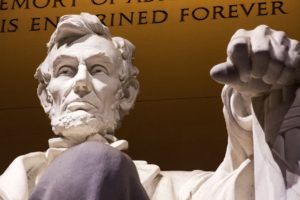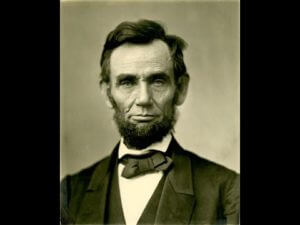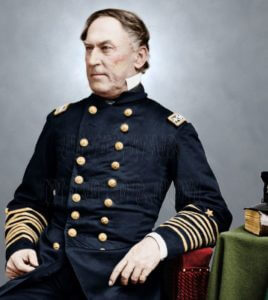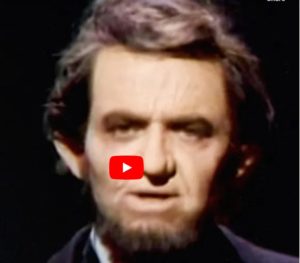By Dan Friesen
In 1992, my first year leading tours with my father, George Friesen, we took a crazy, cross-country marathon focused on reaching New England during the fall foliage season. We also walked in Washington D.C., however, and I’ll always remember my first visit to the Lincoln Memorial at the west end of the magnificent National Mall.

I remember standing there gazing up at the words of Lincoln’s second inaugural address inscribed in white marble behind his somber, seated statue. I marveled at the rhythm of the words, their gentle economy of purpose, and the soothing message of reconciliation as the end of the Civil War seemed imminent: “With malice towards none. With charity towards all.” I remembered my father, history teacher-cum-travel guide, quoting these immortal words more than once.
“With malice towards none. With charity towards all.”
The date of Lincoln’s second inaugural address was March 4, 1865, 158 years ago today.
WAI Historical Ironies
Last fall, on Saturday, November 19, I posted a blog in the Saturday Report about Lincoln’s Gettysburg Address, easily our 16th president’s most famous and oft-quoted speech. For the past several months, I have been slowly digesting a 3-volume history, The Civil War, A Narrative, by Shelby Foote. I found it delightfully ironic that the week leading up to November 19, I had just come across Foote’s extensive account of this initially underwhelming speech. Furthermore, our Hiking the Appalachian Trail group had walked in Gettysburg National Military Park just a few weeks earlier.
A second layer of irony is that today, Saturday, March 4, 2023 is the 158th anniversary of Lincoln’s second inaugural address, Lincoln’s second most quoted speech. And I just last week finished reading Foote’s account of the buildup to and culmination of that event, coming just a few weeks before Lee’s surrender at Appomattox.

Meanwhile, our Heart of the South group left Alabama this morning and has been or will be walking and visiting Baton Rouge and New Orleans, Louisiana; Vicksburg and Jackson, Mississippi; Montgomery, Alabama; Charleston and Columbia, South Carolina; and Savannah and Atlanta Georgia, all strategic names on the checkerboard of the earthshaking conflict we call the American Civil War (often referred to in the South as “The War Between the States”); all places with prominent roles in The Civil War, A Narrative.
That the anniversaries of Lincoln’s two most famous speeches would fall on Saturdays just after they appeared in my reading of The Civil War trilogy, shortly after WAI groups had been in the area, is the kind of coincidence I find intriguing.
The Speech That Nearly Wasn’t
Lincoln’s second inaugural address might not have a title as recognizable as the Gettysburg Address, but it was no less profound and widely considered a masterpiece of both statesmanship and communication. Charles F. Adams, grandson of our second president, John Adams, wrote to his father, John Quincy Adams, our sixth president, “That rail-splitting lawyer is one of the wonders of the day. Once at Gettysburg and now again on a greater occasion he has shown a capacity for rising to the demands of the hour which we should not expect from orators or men of the schools. This inaugural strikes me in its grand simplicity and directness as being for all time the keynote of this war.”
“That rail-splitting lawyer is one of the wonders of the day.”
It was a speech that nearly wasn’t. A few short months before the 1864 election, it was unlikely Lincoln would be reelected. His character, vision, wisdom, and leadership abilities, not to mention gifts as a communicator, were mostly unrecognized and unappreciated during the white-hot fury of the Civil War.
The war was not going well for the Union. Casualty lists were appalling. The American Civil War was by far the deadliest in our history, with over 1 million casualties (deaths, wounded in action, diseases, prisoners of war) more than double the amount of our second most deadly war, World War II.
Northerners were understandably weary of the carnage. Sacrifices requested were of the ultimate. Advisors, friends, and political allies warned Lincoln that his election was impossible. The electorate was “wild for peace”.
Foote records how Henry J. Raymond, editor of the sympathetic New York Times and chairman of the Republican National Executive Committee wrote Lincoln a letter saying, “I feel compelled to drop you a line concerning the political condition of the country as it strikes me. I am in active correspondence with your staunchest friends in every state, and from them all I hear but one report. The tide is setting strongly against us.”
Somehow the public had become convinced that peace with the South was possible without dividing the country. According to Foote, one friend wrote: “In some way or other the suspicion is widely diffused that we can have peace with Union if we would. It is idle to reason with this belief—still more idle to denounce it.”

Lincoln saw the writing on the wall. On August 23, 1864, just over two months before the election, he wrote the following memorandum to his cabinet. “This morning, as for some days past, it seems exceedingly probably that this Administration will not be reelected. Then it will be my duty to so cooperate with the President-elect as to save the Union between the election and the inauguration; as he will have secured his election on such ground that he cannot possibly save it afterwards.”
Lincoln’s unpopularity was due to his determination to continue the fight to maintain the Union and eradicate slavery despite the higher than expected cost in lives. His opponent, General George McClellan, was expected to defeat him at the polls by offering peace that was possible only by sacrificing these two high objectives, even though McClellan’s platform maintained the opposite, that peace was possible without sacrificing these ideals.
Lincoln realized that in this scenario he would have a window of time between his loss of the election in November 1864 and the inauguration of the new president on March 4, 1865, a period of under four months, to win the war and save the Union. Foote tells us how Lincoln’s two secretaries explained his memo: “In this peculiar fashion, he pledged himself and the Administration to accept loyally the anticipated verdict of the people against him, and to do their utmost to save the Union in the brief remainder of his term of office.”
Three Turning Points in 1864
But that turned out not to be necessary. During August, September, and October of 1864, the tide of the war changed dramatically and quickly. Several decisive Union victories brought the end of the unbelievably bloody and fratricidal conflict into view. The Battle of Mobile Bay in early August 1864, the fall of Atlanta in early September, and General Phillip Sheridan’s Shenandoah Valley campaign in early October completed flipped the fatalistic sentiment towards the war in the North.
Battle of the Mobile Bay: Mobile and its blockade-running ships seemed invincible behind the defending forts and ironclad ships of massive Mobile Bay. Yet it was finally brought under Union control in early August by Admiral Farragut under extraordinary circumstances.

A remarkable figure in his own right, Farragut already had 54 years of service to his credit, having started his naval career as a midshipman at the remarkably tender age of 9. Farragut and this pivotal Battle of Mobile Bay produced one of the American Navy’s iconic quotes.
It came about like this. The approach to the Bay was limited to a narrow channel flanked by Confederate torpedo-infested waters (now called mines). This was the route taken by the Confederate blockade runners.
Farragut had deployed nighttime crews to disable the torpedoes (mines) but the job had not been completed, leaving the narrow channel as the only safe course. On the morning of the Federal attack, Farragut’s lead ship, the Brooklyn, became stuck crossways in the channel.
The single file armada was immobilized, bottlenecked behind the immovable Brooklyn, and subjected to withering fire from Confederate cannons on Mobile Point. Farragut’s flagship, Hartford, directly behind the Brooklyn, sat helpless.
Farragut himself, lashed high in the rigging of the Hartford to give a vantage point of the battle above the smoke of the cannons, saw that his ships were sitting ducks being decimated by incoming Confederate fire. Inaction would be fatal. They must either move forward or reverse course and abandon the long-planned-for attack. Foote records Farragut’s writing that in the heat of battle “in his extremity, he called on God, ‘Shall I go on?’ and received an answer from a commanding voice inside his head: ‘Go on’.”
“Going on” meant steaming around the stalled ships ahead of him, outside the safe channel, into waters littered by mines. From high in the rigging, Farragut shouted the order to pass the Brooklyn on the left. Someone called up a reminder of the torpedoes they would encounter and Farragut gave his now famous reply. “Damn the torpedoes”, he cried. “Full speed ahead.”
“Damn the torpedoes! Full speed ahead.”
Torpedoes were encountered, but either they were duds, or they had been defused by Farragut’s night crews. So it is that Farragut’s gutsy decision saved the day, resulted in the Confederacy’s loss of their one remaining port in the Gulf of Mexico, began the turning the tide of the Civil War, and led to Lincoln’s 2nd inaugural address.
Fall of Atlanta: The second turning point came in Georgia. General William Tecumseh Sherman, “Uncle Billy” to his troops, had pursued General Joe Johnston and the Confederate Army of Tennessee for over two months from the Tennessee border with Georgia to the outskirts of Atlanta.
After another two months of engagements and siege, the final fall of the city’s considerable fortifications was announced by wire from Sherman to Washington on September 3, “Atlanta is ours, and fairly won.”
“Atlanta is ours, and fairly won.”
Atlanta was a strategic resource. It was a lynchpin of Southern industrial might, a transportation hub of the critical rail system, and an incalculable loss to the cause of the Confederacy.
Sheridan’s Shenandoah Valley campaign: The final turning point was General Phillip Sheridan’s march through the Shenandoah Valley in early October. Sheridan overcame Confederate General Jubal Early in a series of three stunning victories. In the last, he almost single-handedly converted a shattering defeat to overwhelming victory during a 12-mile ride, “Sheridan’s Ride”, rallying his retreating army to “About face!” and “Get a twist on those fellows!” Control of the Shenandoah Valley gave the North the ability to destroy a primary breadbasket of the South and a vital supply pipeline to Lee’s army entrenched around Richmond and Petersburg.
“Get a twist on those fellows!”
The result of this abrupt change in the tide in the war was an electoral landslide for Lincoln on November 8 with over 212 electoral votes to McClellan’s 21.
Lincoln’s Shift Towards Reconciliation
Relieved of the pressure of saving the Union before a new president took office, Lincoln turned his attention to the reunification that would follow the end of the war. This redirection is reflected in his inaugural address. It was again short, like Gettysburg, the shortest inaugural address since Washington’s second inaugural.
This was an era when politicians and presidents wrote their own speeches. This was a day before teleprompters. On March 4, 1864, during the outdoor ceremony before the newly completed Congress, Lincoln came forward to enthusiastic applause, his speech written on a single large sheet of paper in two columns, only 707 words, much shorter than this blog.
What struck me that fall day in 1992, standing at the Lincoln Memorial in Washington D.C., were the lines now most famous with which Lincoln ended the speech:
“With malice toward none with charity for all with firmness in the right as God gives us to see the right let us strive on to finish the work we are in to bind up the nation’s wounds, to care for him who shall have borne the battle and for his widow and his orphan ~ to do all which may achieve and cherish a just and lasting peace among ourselves and with all nations.”
Read the full speech here
36 days later, the war ended with Robert E. Lee’s surrender at Appomattox Courthouse.
41 days later, Lincoln was dead, assassinated at Ford’s Theatre by John Wilkes Booth.
One of the great unanswerables of history is: How would the USA have been different had Lincoln been able to continue to carry out his plans for reunification of North and South?
How would the USA have been different had Lincoln been able to continue to carry out his plans for reunification of North and South?
His death left a statesmanship vacuum not to be filled in the post-Civil War era. What followed was a period of acrimony and bitterness as the country struggled with the complex problems of reintegrating states of the Confederacy and enabling the slavery-to-freedom transition of 4 million former slaves.
This complicated period of Reconstruction would have taxed any people and any leader; it required the wisdom, courage, and communication abilities of an Abraham Lincoln.


